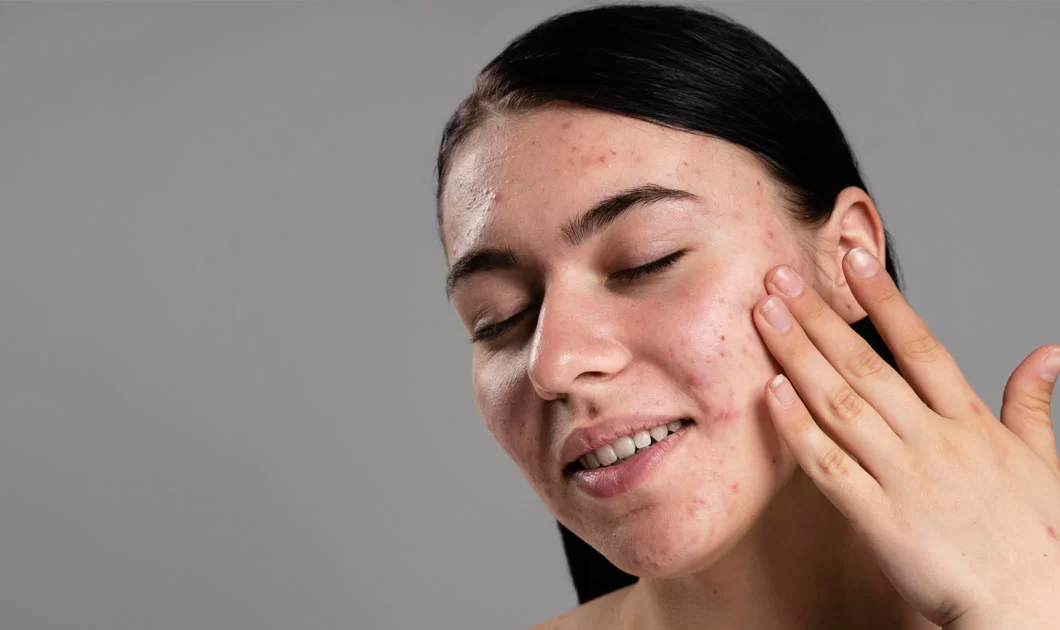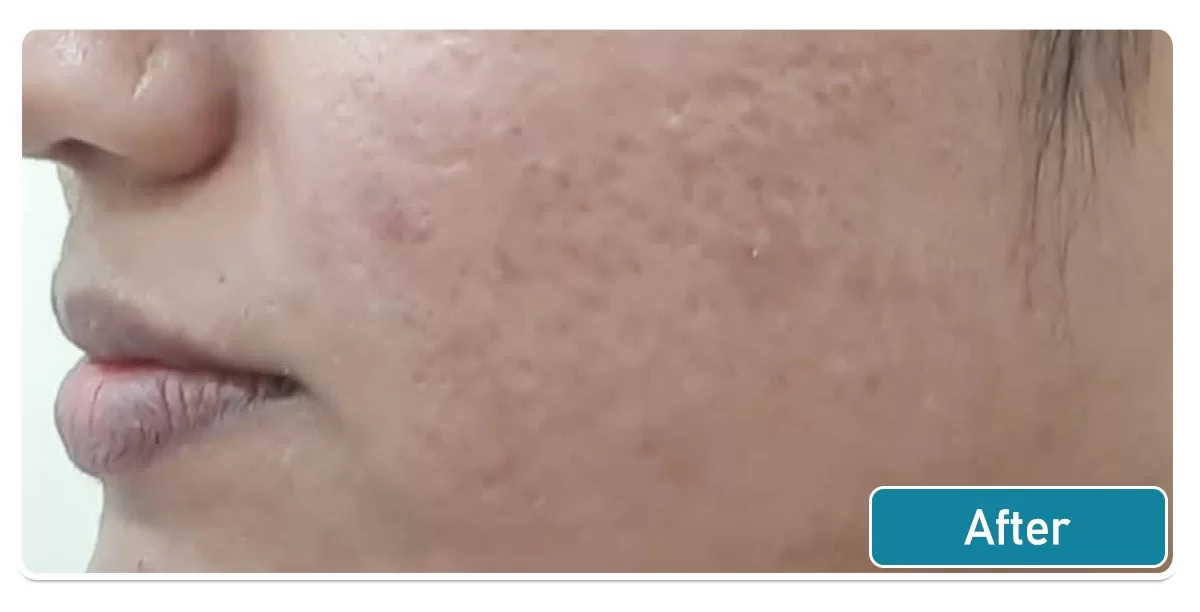ACNE SCAR TREATMENT
Acne Scars: Types, Diagnosis & Correction Options
Acne can cause permanent scarring, regardless of age, gender, or skin type. It affects around 90% of the global population during teenage years, leaving scars on the face, forehead, nose, chest, and back. These scars alter the texture of the skin and can appear as pits, raised scars, or marks. Dermatologists can treat acne scars, with the duration of treatment ranging from 3 to 24 months depending on the type of scarring. While mild scars are easier to treat, deep and old scars may require multiple sessions to achieve noticeable improvement.
What Are Acne Scars And Why Do They Form?
Acne scars are marks or depressions that occur on the skin after breakouts have subsided. When excessive sebum, dead cells, and bacteria clog skin pores, it causes inflammation and acne. Mild acne may cause post-inflammatory hyperpigmentation or pimple marks, but deeper lesions can harm collagen and permanently affect the skin’s texture. As 90% of teenagers experience pimples, acne scars are a common skin concern that requires medical attention. To minimize acne scars, it is essential to effectively manage pimples first. Let’s explore the primary causes of acne scars before discussing their types and treatments. Learn more about Glamour Skin Studio’s Acne Scar Treatment.

What Causes Acne Scars?
Acne scars can result from any grade or severity of acne based on the skin’s healing response. However, if you have severe breakouts consisting of cysts and nodules, delayed response to inflammatory acne treatment, or picked, popped, or squeezed acne, you may be at a higher risk of developing acne scars. Additionally, if you have a family history of acne and acne scars, you may be more prone to them. If you can relate to any of these scenarios, you may have acne scars. Understanding the type of acne scar you have is crucial as it determines the specialized treatment you may require to reduce it.
Types Of Acne Scars:
There are two main types of acne scars: atrophic (depressed) and hypertrophic (elevated). These scars form depending on the levels of collagen in the skin during the healing process after a breakout. Only 10% of acne scars fall under the hypertrophic category, also known as keloids. Atrophic scars can be further classified into three subtypes based on their appearance. Ice pick scars are narrow, vertical scars with sharp edges and a diameter of under 2mm. Rolling scars are pits in the skin with a diameter of up to 5mm, round edges, and an undulating appearance. Boxcar scars are larger than rolling scars, with defined edges and a width ranging from 1.5mm to 4mm. The effectiveness of scar revision treatment depends on the type and severity of the scar. Acne scars can develop due to various skin injuries like burns, wounds, vaccinations, surgeries, and acne. These scars may present themselves as deep pits, raised lesions, or dark pigmentation. A dermatologist can identify the severity of the scars and recommend a treatment plan. To prevent acne scars, it is best to seek medical attention as soon as breakouts occur, avoid popping pimples, and refrain from picking scabs. Home remedies and self-care methods may not be safe or effective and may even worsen inflammation, trigger acne, or cause severe side effects. If these prevention tips do not work, it is advisable to seek professional solutions.


Professional Treatment Options For Acne Scars:
Our esteemed dermatologists utilise cutting-edge laser technology that is approved by the USFDA to stimulate collagen production in scarred tissue through Pixel Laser Skin Resurfacing. Additionally, our medical team employs Micro-needling Radiofrequency, which not only treats acne scars but also tightens the skin and improves its texture.
Those seeking a more traditional approach may opt for Chemical Peels, wherein plant-based extracts are applied by our experienced team to exfoliate damaged skin layers. For those with ice pick scars, TCA Cross peel is a specialised treatment offered by our experts to minimise their appearance.
Our minimally invasive Subcision treatment is performed by our highly skilled doctors and is proven to effectively reduce the depth of acne scars. Additionally, our medical team administers Intralesional Injections that visibly reduce the size of raised acne scars.
Lastly, Laser Toning is an advanced modality that employs state-of-the-art laser technology to reduce the appearance of flat, red and pigmented acne scars. Our skilled professionals utilise this treatment to correct post-acne skin discolouration.
Glamour Skin Studio’s team of expert dermatologists offers comprehensive pre and post-treatment advice to ensure optimum results for acne scar treatments. They prioritize safe and efficient procedures with minimal downtime and side-effects to provide the best possible care for their clients.
How To Get Started?
To book a consultation session with our leading team for non-surgical skin tightening treatments at Glamour Skin Studio, call us on our toll-free number 6287878787 or submit the form available on our website. Our customer support team will connect with you shortly to help you schedule your visit to Glamour Skin Studio Skin & Hair Clinic based on your preferred location, date, and time.
make your appointment with
our skin specialist in Surat
Make Appointment FAQ
What causes acne scars, and who is more likely to get them?
Acne scars usually occur because of severe or untreated acne, particularly cysts or nodules. Those who wait, squeeze spots, or have a history of acne in their families are more likely to have scars.
Can home remedies cure acne scars effectively?
Home remedies are not advisable to treat acne scars because they could further aggravate inflammation or damage the skin. Professional treatments are safer and more scientifically proven.
Can Dr. Sheena Singh treat various forms of acne scars, such as ice pick, rolling, and boxcar scars?
Yes, Dr. Sheena Singh provides individualized treatment plans in Surat for any form of acne scars whether they are atrophic (such as ice pick, rolling, or boxcar scars) or hypertrophic. Following a thorough skin evaluation, she suggests appropriate procedures like laser treatment, microneedling, chemical peel, or fillers, based on the type of scar and severity.
What is TCA Cross treatment, and who can undergo it?
TCA Cross is a type of chemical peel utilized to treat ice pick scars. It entails applying a high percentage of trichloroacetic acid directly into the scar to promote collagen formation and minimize depth.
How do I know which acne scar treatment is right for me?
Our experienced dermatologists perform a one-on-one consultation and skin evaluation to identify your scar type and prescribe the most suitable treatment plan customized to your requirements.
Do acne scar treatments require downtime or recovery time?
Most Glamour Skin Studio treatments are low-downtime, minimally invasive. Your physician, Dr. Sheena Singh, will instruct you on individualized aftercare depending on the treatment selected to provide optimal healing and best results.

Best psychology & counseling to help you understand the problems.
Contact
© 2023 Glamour Skin Studio. All Rights Reserved.